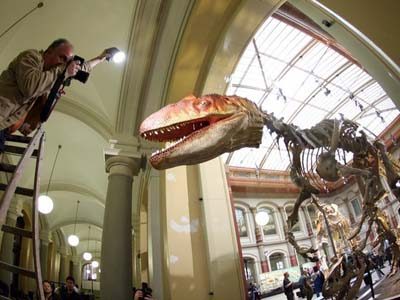World's biggest dinosaur lives in world's trendiest town
 Berlin - Where else would the world's biggest dinosaur live, but in the world's trendiest town?
Berlin - Where else would the world's biggest dinosaur live, but in the world's trendiest town?
"Live" may be stretching it a bit. Brachiosaurus brancai has been dead for 150 million years, but he remains impressive, towering more than 13 metres over visitors to Berlin's Naturkundemuseum (Natural History Museum).
The fact that many of the visitors are little - children are the museum's most enthusiastic visitors - only adds to his stature.
Brachiosaurus is big - very big. His head measures about a metre from the tip of his nose to the back of his skull and his heart is thought to have weighed 400 kilogrammes.
The refurbished museum in old East Berlin, a 15-minute stroll along Invalidenstrasse from the main central station, reopened in July last year.
It now has special-effects binoculars that show how Brachiosaurus looked and moved around his environment.
The special effects first show the skeleton as it is displayed in the museum, then add muscle and sinew, followed by skin.
After that the dinosaurs dance about, chewing chunks out of the late Jurassic vegetation - and each other.
Brachiosaurus is definitely the star of the show. He - if it is a he - has two heads.
One is fixed where it should be, at the end of his neck way up high, and the second mounted on a low pedestal at ground level so that visitors can get a closer look.
The second head is in fact a three-dimensional digital copy that shows the huge holes in the skull through which this immense beast once breathed.
This Brachiosaurus is the largest mounted dinosaur specimen in the world, measuring 15.5 metres long and 13.27 metres high. Apparently he weighed in at 50 tons and could run at up to 17 kilometres an hour.
While Brachiosaurus is definitely the biggest attraction, the museum has much else to offer.
A realistic lion facing an equally life-like zebra are testimony to one of the it's key interests - taxidermy, or stuffing animals for display.
An exhibition reveals the history of this art, showing how it has developed down the years.
Some of the fossils are astonishing. A fish seems almost ready to leap from the stone.
Open every day of the year, the museum, www. museum. hu-berlin. de, charges adults 6.00 euros (9 dollars) and children 3.50. (dpa)